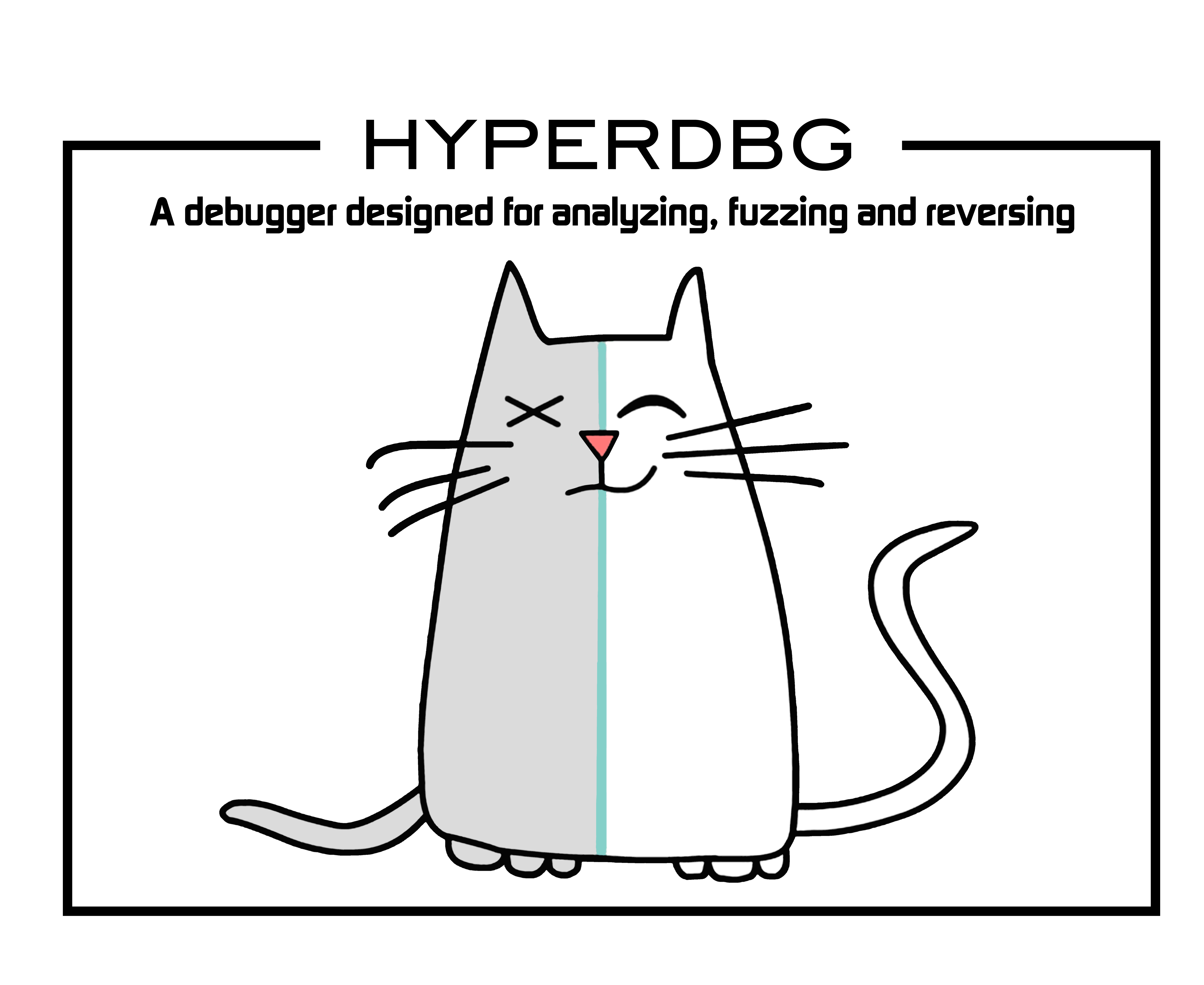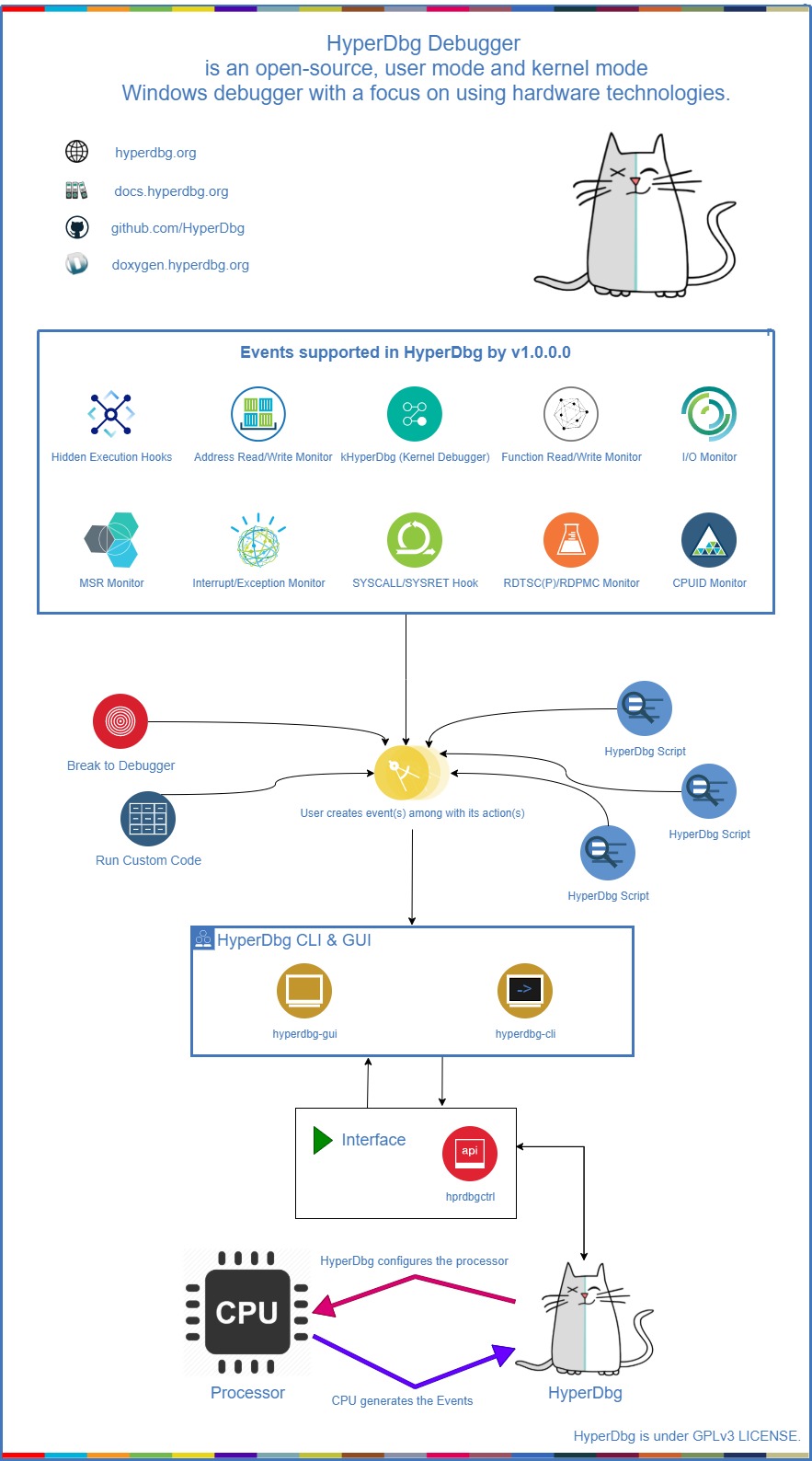HyperDbg Debugger is an open-source, community-driven, hypervisor-assisted, user-mode and kernel-mode Windows debugger with a focus on using modern hardware technologies. It is a debugger designed for analyzing, fuzzing and reversing.
Follow HyperDbg on Twitter to get notified about new releases.
HyperDbg is designed with a focus on using modern hardware technologies to provide new features to the debuggers' world. It operates on top of Windows by virtualizing an already running system using Intel VT-x and Intel PT. This debugger aims not to use any APIs and software debugging mechanisms, but instead, it uses Second Layer Page Table (a.k.a. Extended Page Table or EPT) extensively to monitor both kernel and user executions.
HyperDbg comes with features like hidden hooks, which is as fast as old inline hooks, but also stealth. It mimics hardware debug registers for (read & write) to a specific location, but this time entirely invisible for both Windows kernel and the programs, and of course without any limitation in size or count!Using TLB-splitting, and having features such as measuring code coverage and monitoring all mov(s) to/from memory by a function, makes HyperDbg a unique debugger.
Although it has novel features, HyperDbg tries to be as stealth as possible. It doesn’t use any debugging APIs to debug Windows or any application, so classic anti-debugging methods won’t detect it. Also, it resists the exploitation of time delta methods (e.g., RDTSC/RDTSCP) to detect the presence of hypervisors, therefore making it much harder for applications, packers, protectors, malware, anti-cheat engines, etc. to discover the debugger.
You can download latest compiled binary files from releases; otherwise, if you want to build HyperDbg, you should clone HyperDbg with the --recursive flag.
git clone --recursive https://github.com/HyperDbg/HyperDbg.git
Please visit Build & Install and Quick Start for a detailed explanation of how to start with HyperDbg. You can also see FAQ for more information.
In case you use one of HyperDbg's components in your work, please consider citing our paper.
1. HyperDbg: Reinventing Hardware-Assisted Debugging (preprints.org)
@article{karvandi2022hyperdbg,
title={HyperDbg: Reinventing Hardware-Assisted Debugging},
author = {Karvandi, Mohammad Sina and Gholamrezaei, MohammadHosein and Khalaj Monfared , Saleh and Medi , Soroush and Abbassi, Behrooz and Amini, Ali and Mortazavi , Reza and Gorgin , Saeid and Rahmati , Dara and Schwarz, Michael},
year={2022},
doi = {10.20944/preprints202205.0416.v1},
publisher={Preprints}
}
- Advanced Hypervisor-based Kernel Mode Debugger [link][link][link]
- Classic EPT Hook (Hidden Breakpoint) [link][link][link]
- Inline EPT Hook (Inline Hook) [link][link]
- Monitor Memory For R/W (Emulating Hardware Debug Registers Without Limitation) [link][link][link]
- SYSCALL Hook (Disable EFER & Handle #UD) [link][link][link]
- SYSRET Hook (Disable EFER & Handle #UD) [link][link]
- CPUID Hook & Monitor [link][link]
- RDMSR Hook & Monitor [link][link]
- WRMSR Hook & Monitor [link][link]
- RDTSC/RDTSCP Hook & Monitor [link]
- RDPMC Hook & Monitor [link]
- VMCALL Hook & Monitor [link]
- Debug Registers Hook & Monitor [link]
- I/O Port (In Instruction) Hook & Monitor [link][link]
- I/O Port (Out Instruction) Hook & Monitor [link][link]
- MMIO Monitor [link]
- Exception (IDT < 32) Monitor [link][link][link]
- External-Interrupt (IDT > 32) Monitor [link][link][link]
- Running Automated Scripts [link]
- Transparent-mode (Anti-debugging and Anti-hypervisor Resistance) [link][link]
- Running Custom Assembly In Both VMX-root, VMX non-root (Kernel & User) [link]
- Checking For Custom Conditions [link][link]
- Process-specific & Thread-specific Debugging [link][link][link]
- VMX-root Compatible Message Tracing [link]
- Powerful Kernel Side Scripting Engine [link][link]
- Support To Symbols (Parsing PDB Files) [link][link]
- Mapping Data To Symbols & Create Structures, Enums From PDB Files [link][link][link]
- Event Forwarding (#DFIR) [link][link]
- Transparent Breakpoint Handler [link][link]
- Various Custom Scripts [link]
(not released yet !)
You can read about internal design of HyperDbg and its features in the documentation. Here's a top-level diagram that shows how HyperDbg works:
You can write your scripts to automate your debugging journey. HyperDbg has a powerful, fast, and entirely kernel-side implemented script engine.
- All of the contributors
- Mohammad Sina Karvandi (@Intel80x86)
- MH Gholamrezaei (@mohoseinam)
- Website by Mohammad Ataei (@mammadataei)
- Saleh Khalaj Monfared (@S4l3hh)
- Alee Amini (@AleeAmini)
- Behrooz Abbassi (@BehroozAbbassi)
- Zyantific Team for Zydis Disassembler
- Petr Benes (@PetrBenes) for ia32-doc, pdbex
- Process Hacker Team for phnt
Contributing in HyperDbg is super appreciated. We have made a list of potential tasks that you might be intersted in contributing towards.
If you want to contribute in HyperDbg please read Contribution Guide.
HyperDbg, and all its submodules and repos, unless a license is otherwise specified, are licensed under GPLv3 LICENSE.
Dependencies are licensed by their own.








